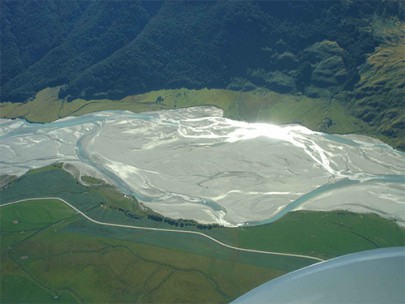Subterranean river gravels
In this section

Subterranean river gravels are commonly associated with braided rivers such as the Matukituki River (Susan Wiser)
Subterranean river gravels are found mainly beneath braided rivers and can be divided into two intergrading zones. The hyporheic zone is the saturated interstitial area beneath the streambed, and into the stream banks, which contains some proportion of channel water, or that has been altered by channel water infiltration (White 1993). Beyond this is the phreatic zone where water permanently saturates the interstices, and is referred to as groundwater. Thus the depth of the hyporheic zone and the points where the hyporheic and phreatic zones merge vary from reach to reach and are unknown in most rivers. As there is no photosynthesis in these combined zones, animals are dependent on organic material derived from outside.
Notable flora and fauna
These systems have quite low diversity in terms of species numbers compared with surface ecosystems, but a high proportion of species are peculiar either to this ecosystem or to this and other subterranean ecosystems. They also display differences in faunal make–up from surface ecosystems – e.g. in surface freshwater aquatic ecosystems, insects play the predominant role; in subterranean ecosystems, crustacean and hydrobiid snails are far more predominant and these groups display their highest species diversity in subterranean habitats.
The fauna of these systems is not sufficiently well understood to classify species by threat category. The stygobitic (restricted to groundwaters) invertebrates living in these habitats are dominated by copepods, with lesser numbers of amphipods, gastropods (e.g. Hadopyrgus brevis, Saganoa mica), and Aranae (e.g. Anopsolobus subterraneus) (see Scarsbrook & Fenwick 2003).
Threat status
Not threatened (Holdaway et al. 2012)
Threats
Agriculture poses a threat because of groundwater pollution, especially with nitrates and excessive groundwater abstraction. Urbanisation is not as widespread as agricultural impacts, but impacts may be highly significant over small areas, especially via land–based sewage effluent disposal.
Where do they occur?
On the likely assumption these systems are found mainly in association with braided rivers, they occur throughout the South Island, particularly on the eastern side, and south of the Buller River in the west. In the North Island they occur mainly on both sides of the axial ranges from East Cape southwards.
Further reading
Gray D, Harding JS 2007. Braided river ecology: a literature review of physical habitats and aquatic invertebrate communities. Wellington, Department of Conservation. 50 p.
Scarsbrook MR, Fenwick GD 2003. Preliminary assessment of crustacean distribution patterns in New Zealand groundwater aquifers. New Zealand Journal of Marine and Freshwater Research 37: 405–413.
White DS 1993. Perspectives on defining and delineating hyporheic zones. Journal of the North American Benthological Society 12: 61–69.


